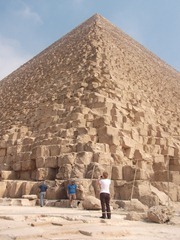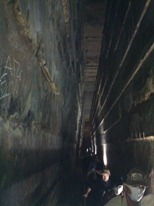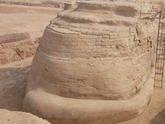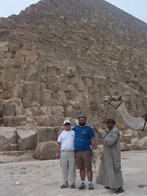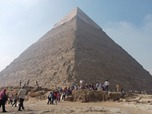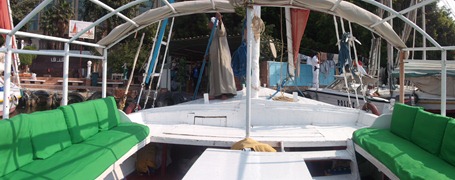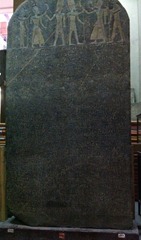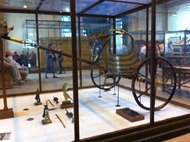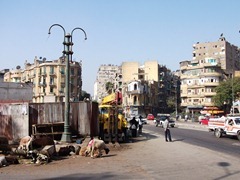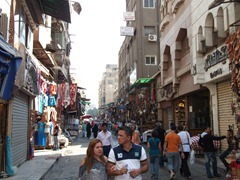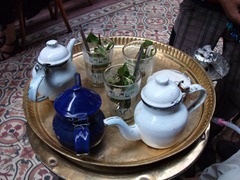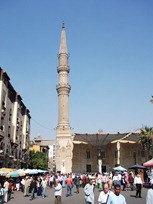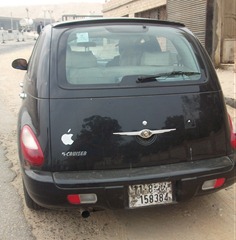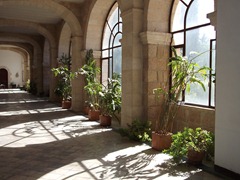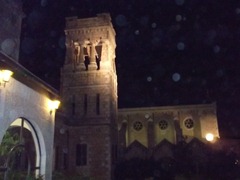The Beard Goes Home is a chronicle of my trip to Jerusalem, Cairo and Rome from November 3-18. If you want more information on a picture, hover your mouse over it for a pop-up caption. If you want to see a bigger version of the picture, click on it.
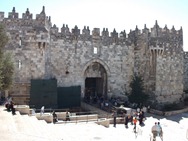 Our second day in Jerusalem started with some fantastic coffee at a small bookstore around the corner from the School. Thomas and I decided we would walk the typical path Jesus would’ve used when he came to Jerusalem. When Jesus visited, he stayed in Bethany with Mary, Martha and Lazarus. From there, he would walk into Jerusalem, passing through the Mount of Olives. (Of course, since Thomas and I were already in Jerusalem, we would do it backwards – out to Bethany and back.) I was looking forward to experiencing the geography of Jesus, and I was not disappointed (for Bible nerds – this is also the route David took when he fled from Absalom in 2 Kings 15)
Our second day in Jerusalem started with some fantastic coffee at a small bookstore around the corner from the School. Thomas and I decided we would walk the typical path Jesus would’ve used when he came to Jerusalem. When Jesus visited, he stayed in Bethany with Mary, Martha and Lazarus. From there, he would walk into Jerusalem, passing through the Mount of Olives. (Of course, since Thomas and I were already in Jerusalem, we would do it backwards – out to Bethany and back.) I was looking forward to experiencing the geography of Jesus, and I was not disappointed (for Bible nerds – this is also the route David took when he fled from Absalom in 2 Kings 15)
 We walked to the Damascus gate and then along the outside of the city walls, which are impressive and imposing. A word of explanation: modern-day Jerusalem is quite a bit larger than the Jerusalem of Jesus’ time (which is, in turn, much bigger than the original ‘City of David’ that David founded). The Old City is contained inside the large walls you see in the pictures, and even the Old City is significantly bigger than Jesus’ Jerusalem (for instance, the Church of the Holy Sepulcher, which contains Calvary and the Tomb, is built on land that was ‘outside the city’ according to the gospels). Probably the biggest surprise to me so far has been how small Jesus’ Jerusalem was. I’ve been to few sub-divisions that are as small as Old Jerusalem (in fact, I’m relatively certain that the apartment complex in which I currently live is bigger than the Old City).
We walked to the Damascus gate and then along the outside of the city walls, which are impressive and imposing. A word of explanation: modern-day Jerusalem is quite a bit larger than the Jerusalem of Jesus’ time (which is, in turn, much bigger than the original ‘City of David’ that David founded). The Old City is contained inside the large walls you see in the pictures, and even the Old City is significantly bigger than Jesus’ Jerusalem (for instance, the Church of the Holy Sepulcher, which contains Calvary and the Tomb, is built on land that was ‘outside the city’ according to the gospels). Probably the biggest surprise to me so far has been how small Jesus’ Jerusalem was. I’ve been to few sub-divisions that are as small as Old Jerusalem (in fact, I’m relatively certain that the apartment complex in which I currently live is bigger than the Old City).
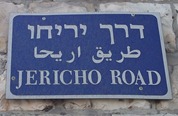 I quickly noticed that Jerusalem is on a large hill. We rounded the corner and found the road that would lead us towards the Mount of Olives: the Jericho road! In the parable of the Good Samaritan (Luke 10:25-37), Jesus says this:
I quickly noticed that Jerusalem is on a large hill. We rounded the corner and found the road that would lead us towards the Mount of Olives: the Jericho road! In the parable of the Good Samaritan (Luke 10:25-37), Jesus says this:
“A certain man went down from Jerusalem to Jericho, and fell among thieves, which stripped him of his raiment, and wounded him, and departed, leaving him half dead (emphasis mine).”
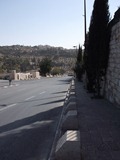 You can sense immediately that this is not figurative language. The Jericho drops sharply down into the Kidron Valley (which means ‘deep’ in Hebrew) before heading up over the Mount of Olives. I quickly realized that Hebrew names are not interested in creativity; they’re very, very literal. Kidron is a deep valley, and the Mount of Olives is a mountain. With olives growing on top of it.
You can sense immediately that this is not figurative language. The Jericho drops sharply down into the Kidron Valley (which means ‘deep’ in Hebrew) before heading up over the Mount of Olives. I quickly realized that Hebrew names are not interested in creativity; they’re very, very literal. Kidron is a deep valley, and the Mount of Olives is a mountain. With olives growing on top of it.
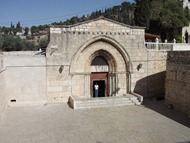 We walked down the Jericho road, away from Jerusalem. At the bottom of the valley, we visited the Church of the Virgin’s Tomb. According to Church Tradition, immediately after Mary died, the disciples took her to this place and God assumed her body up into heaven. The church is at the bottom of the valley, and we walked down into a low courtyard even to enter the church. Once inside the church, we walked down another huge, elaborate staircase into the main body of the church. The slab on which Mary’s body was laid is now enclosed in a structure, but we were allowed to enter and see the slab.
We walked down the Jericho road, away from Jerusalem. At the bottom of the valley, we visited the Church of the Virgin’s Tomb. According to Church Tradition, immediately after Mary died, the disciples took her to this place and God assumed her body up into heaven. The church is at the bottom of the valley, and we walked down into a low courtyard even to enter the church. Once inside the church, we walked down another huge, elaborate staircase into the main body of the church. The slab on which Mary’s body was laid is now enclosed in a structure, but we were allowed to enter and see the slab.

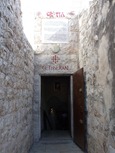 By the time we left the Church of the Virgin’s Tomb, we had just enough time to visit the site where the disciples slept while Jesus was praying in the Garden of Gethsemane (all the holy sites close from noon until two). Even with all the buildings that exist here now, you can feel how close everything is. The Garden of Gethsemane is near the bottom of the Kidron. As Jerome O’Conner points out, it makes a great place to stop before you hike up the Mount of Olives. It’s easy to imagine Jesus and the disciples stopping here after they’ve left the city on their way back to Bethany for the night – a great chance to debrief and relax.
By the time we left the Church of the Virgin’s Tomb, we had just enough time to visit the site where the disciples slept while Jesus was praying in the Garden of Gethsemane (all the holy sites close from noon until two). Even with all the buildings that exist here now, you can feel how close everything is. The Garden of Gethsemane is near the bottom of the Kidron. As Jerome O’Conner points out, it makes a great place to stop before you hike up the Mount of Olives. It’s easy to imagine Jesus and the disciples stopping here after they’ve left the city on their way back to Bethany for the night – a great chance to debrief and relax.
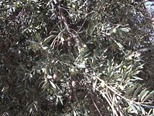 Since everything was now closed, we decided to hike our way up the Mount and head over to Bethany. I thought I was in pretty good shape until we tried this – the Mount of Olives is steep. We had to stop several times to catch our breath and rest, but we eventually made it to the top, where we were greeted by olive trees. Once we got over the hill, we were looking out over the other
Since everything was now closed, we decided to hike our way up the Mount and head over to Bethany. I thought I was in pretty good shape until we tried this – the Mount of Olives is steep. We had to stop several times to catch our breath and rest, but we eventually made it to the top, where we were greeted by olive trees. Once we got over the hill, we were looking out over the other 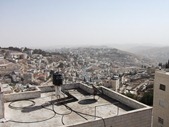 side of the mountain, towards Bethany (which we learned isn’t called Bethany anymore. The name is now el-Azariah, or L-azariah… Lazariah… Lazarus. Neato!
side of the mountain, towards Bethany (which we learned isn’t called Bethany anymore. The name is now el-Azariah, or L-azariah… Lazariah… Lazarus. Neato!
We got nearly all the way to the church built over the site where Jesus raised Lazarus from the dead when we were greeted by the wall very recently finished by the Israelis to keep the Palestinians out. We walked along the wall, noticing that it was covered in graffiti calling for peace, until a guard told us we would get shot in the head if we kept going. So we decided to turn back…

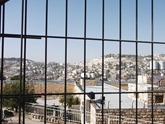 Now we’re heading into Jerusalem the way Jesus would have. As we turned, we saw the Mount of Olives over us, and in the far distance, the Temple Mount. Imagine Jesus’ first view of the city, the Mount of Olives in his foreground and the Temple looming in the distance, dominating the horizon, with the city walls spread around and behind it. I gained a new appreciation for his references to believers as the Light of the World and a City on a Hill much more vivid.
Now we’re heading into Jerusalem the way Jesus would have. As we turned, we saw the Mount of Olives over us, and in the far distance, the Temple Mount. Imagine Jesus’ first view of the city, the Mount of Olives in his foreground and the Temple looming in the distance, dominating the horizon, with the city walls spread around and behind it. I gained a new appreciation for his references to believers as the Light of the World and a City on a Hill much more vivid.

We hiked back up the Mount of Olives and finally had some lunch at a fantastic little café, then began our descent back into the Kidron Valley. A couple of vantage points afforded us some incredible views of the Old City and the Temple Mount. Again, it’s easy to imagine Jesus coming down the Mount of Olives, seeing the city spread out before him and weeping for it as he approached.
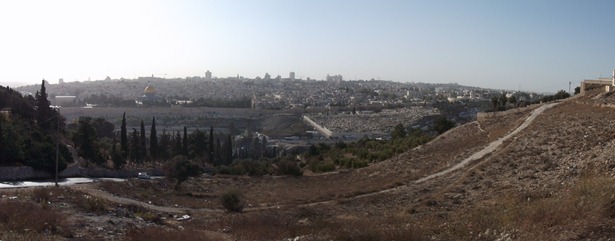
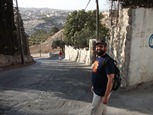 We continued our descent (and did I mention how steep it is? The Mount of Olives does not mess around) and made it back to the valley and the Garden of Gethsemane. The Garden was pretty cool; they’ve maintained a grove of olive trees outside the churches that mark spots where Jesus probably prayed during the night before he was crucified (since he got up to yell at the disciples several times, they’re pretty sure he prayed at multiple spots).
We continued our descent (and did I mention how steep it is? The Mount of Olives does not mess around) and made it back to the valley and the Garden of Gethsemane. The Garden was pretty cool; they’ve maintained a grove of olive trees outside the churches that mark spots where Jesus probably prayed during the night before he was crucified (since he got up to yell at the disciples several times, they’re pretty sure he prayed at multiple spots).

Thomas and I went into the church and I spent some time in prayer, kneeling at the altar just in front of the stone that (probably) marks one of the spots where Jesus prayed. The church building itself is gorgeous – all stone mosaic. The ceiling is covered with Latin phrases like “faithful even to death”. Despite all the tourists coming in and out, my sore limbs and feet, and the man giving some sort of presentation in continental Spanish, I still found the time I spent in prayer very meaningful (and that’s saying something, because I’m easily distracted).
 All the details of the story of Jesus’ arrest (Matthew 26:36-50) became so much more sharp. The disciples sleeping just a few yards away. Jesus weeping and praying. You can imagine him looking back towards the city, seeing the line of torches coming out and saying,
All the details of the story of Jesus’ arrest (Matthew 26:36-50) became so much more sharp. The disciples sleeping just a few yards away. Jesus weeping and praying. You can imagine him looking back towards the city, seeing the line of torches coming out and saying,
“Are you still sleeping and taking your rest? See, the hour is at hand, and the Son of Man is betrayed into the hands of sinners. Get up, let us be going. See, my betrayer is at hand.”
Judas arriving with the guards, identifying Jesus and the guards taking him back up into the city as the disciples fled into the safety of the darkness all around.
We left the Garden and hiked back to the city, making it back just in time to gather our things, pack and leave for Cairo.
All in all, I was most struck by the sheer proximity of everything. Even though Bethany was a hard walk, I’m sure it has more to do with the fact that I’m not in amazing shape and not acclimated to Jerusalem’s altitude yet. Jesus and his disciples made the short trip (maybe 2 miles) twice every day. They had ample opportunity to talk (you know, about fig trees and stuff. Come to think of it, this explains why I never saw any figs… Mark 11:12-26). The Temple was right there – nearly always in view and dominating the landscape. Something like the Triumphal entry – going down the Mount of Olives and into the City would’ve been quite a procession, visible to the thousands of pilgrims headed into the city.
And the city itself was so small (by our standards today). It’s so easy now to see how quickly word traveled. And how much technology changes culture.
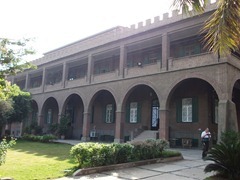 Our last day in Cairo is Monday, November 8 (which is when I’m writing, though you won’t have the chance to read this until at least the end of the week). Because the last five days have been so hectic and crazy, and because Cairo is such a stressful place to be out and about, all three of us have decided to stay in the Institute today to relax and enjoy the peaceful surroundings.
Our last day in Cairo is Monday, November 8 (which is when I’m writing, though you won’t have the chance to read this until at least the end of the week). Because the last five days have been so hectic and crazy, and because Cairo is such a stressful place to be out and about, all three of us have decided to stay in the Institute today to relax and enjoy the peaceful surroundings.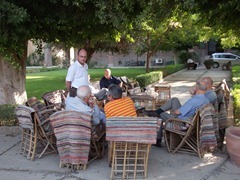 The Switchfoot in my headphones was only occasionally interrupted by horns or sledgehammers from the nearby construction site. I relaxed under the trees, feeling the breeze and the sun, reading or watching the feral cats run all over the grounds, and I felt profoundly at peace.
The Switchfoot in my headphones was only occasionally interrupted by horns or sledgehammers from the nearby construction site. I relaxed under the trees, feeling the breeze and the sun, reading or watching the feral cats run all over the grounds, and I felt profoundly at peace.


